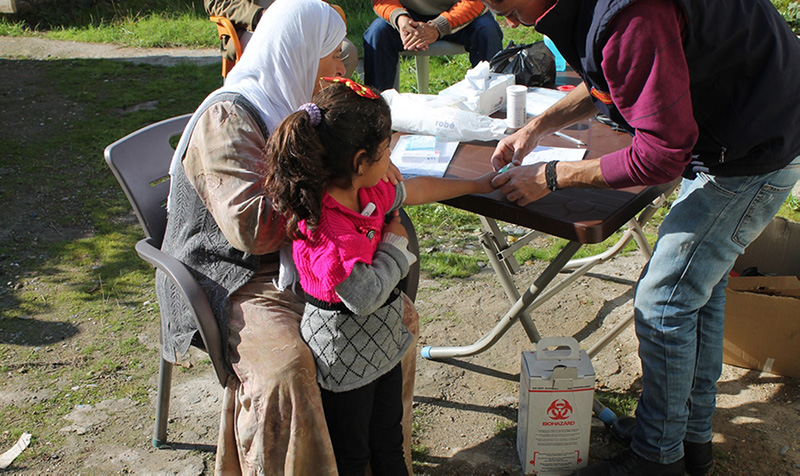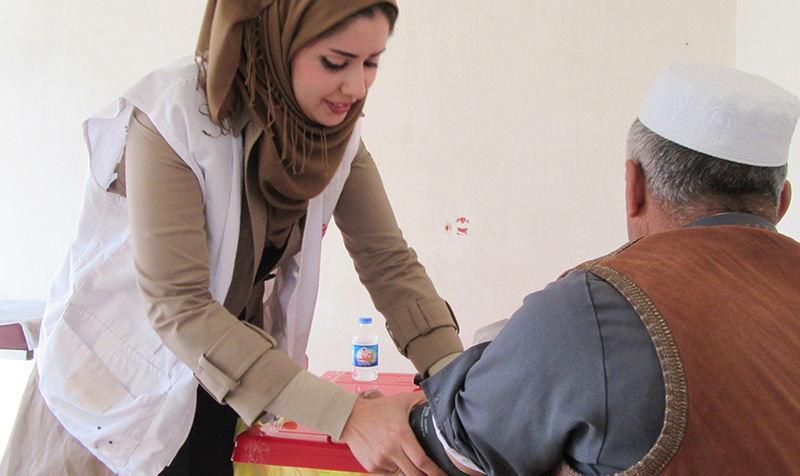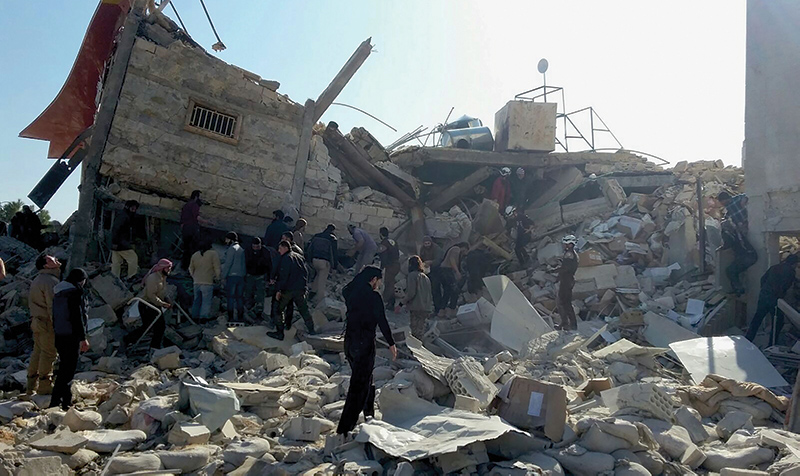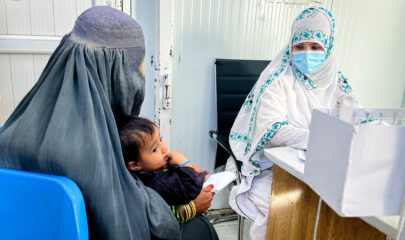THE NEEDS OF MILLIONS HAVEN’T VANISHED
War has threatened lives in Syria for 10 years. Twelve million people – half the pre-conflict population – have been forced to flee their homes, often multiple times, making it the biggest displacement crisis this century.
Syria’s relatively functional health system has been devastated. Hundreds of medical facilities have been bombed, large numbers of medical staff have been killed or have fled.
Doctors Without Borders/Médecins Sans Frontières (MSF) has been providing support to people across different areas of the country since the crisis started: donating medical supplies, setting up hospitals and clinics as well as remotely supporting medical facilities and doctors in areas MSF could not access directly. MSF teams have also been providing support in neighbouring countries hosting Syrian refugees.

2011: PROTESTS TURN TO ARMED CONFLICT
In 2011, Syrians took to the streets to demand democratic reforms. The uprising quickly evolved from minor into massive protests met with state violence and arrests. As protests turned into conflict, Syrians started fleeing to different parts of the country or to neighbouring countries.
For MSF, providing medical care to people within Syria proved challenging from the start of the conflict. From 2011 until today, MSF has not been granted approval to work in government-controlled areas of Syria, despite repeated requests; as a result, our interventions have concentrated on areas outside government control.
MSF still managed to provide medical assistance by supporting networks of Syrian doctors and donating medical and relief items to field hospitals and clinics.
In neighbouring countries such as Lebanon and Jordan, MSF assisted refugees fleeing the violence.

2012: A FULL-FLEDGED WAR
In 2012, the conflict escalated with the participation of different parties. A full-fledged war evolved.
MSF opened hospitals across northern Syria to respond to people’s increasing medical needs in these areas. Most had to be set up in unconventional places, including villas, chicken farms, schools and basements, after a number of medical facilities were hit and destroyed. In these hospitals, MSF teams focused on trauma care and war-related surgeries.
Unable to access the capital, MSF donated relief items and medical supplies to the Syrian Arab Red Crescent in Damascus, including surgical and first aid kits.
As numbers of Syrian refugees increased in neighbouring countries, MSF expanded its activities including in Lebanon and camps in Iraqi Kurdistan.

2013: PEOPLE’S NEEDS INCREASE
By 2013, people in Syria were living the consequences of a deteriorating health system. MSF started witnessing the resurgence of preventable diseases. Cases of measles among children in Aleppo and the first case of polio in Syria in 14 years were indications of a health breakdown, which led to mass vaccination campaigns by MSF in northeast Syria. Medical organizations started to more strongly voice their difficulties meeting needs, let alone dealing with mass casualties and acute emergencies. Due to the intensity of fighting in southern Syria, MSF opened an emergency surgical program in Ramtha, Jordan, near the Syrian border.
Nearby countries experiencing a continuous influx of Syrian refugees started adopting more restrictive border policies. In response, MSF further expanded its work in the region.

2014: DEADLY CLASHES INTENSIFY
In 2014, the UN estimated 6.5 million people had been internally displaced, while more than three million had fled Syria.
The abduction of MSF staff in 2014 led us to stop our activities in areas controlled by the Islamic State group and withdraw internationally hired staff in northwest Syria. Yet we still managed to open projects and increase remote support to medical facilities within Syria.

2015: HUGE DISPLACEMENT CRISIS
In 2015, the number of Syrian refugees passed the four million mark. Thousands were attempting dangerous crossings of the Mediterranean Sea, while another six million were displaced within Syria. It was the biggest displacement crisis since the Second World War. MSF increased its activities across the region, launching search and rescue operations on the Mediterranean and supporting people along their journeys to Europe.
Civilian areas were routinely bombed, often in ‘double-tap’ attacks, in which the initial strike is followed by a second targeting rescue teams or the health facility receiving wounded people.
Within Syria, MSF supported the highest number of health facilities to date, more than 150. However, MSF’s support did not prevent these facilities from being directly impacted by the conflict. In 2015, 23 MSF-supported Syrian health staff were killed and 58 wounded.

2016: PEOPLE TRAPPED
By 2016, many civilian areas had been routinely bombed and deprived of aid. Accessing food and health services was extremely difficult, especially for those living in places under siege.
In December, the Syrian government re-took east Aleppo, but not before its residents had experienced the fiercest bombardment of the five-year war. East Aleppo became the epitome of the conflict, with every atrocity committed: siege warfare, the destruction of hospitals, indiscriminate bombing of civilian areas and a total disregard for the rules of war.
In 2016, 32 medical facilities receiving our support were bombed or shelled on 71 separate occasions.

2017: A RACE FOR TERRITORY
A race to secure territory and control emerged in 2017. MSF treated hundreds of people wounded by war after the intense bombing offensive in Raqqa, as well as people severely injured by booby traps and unexploded ordinances in destroyed homes.
Eleven MSF-supported medical facilities were hit by bombs or shells on 12 occasions in targeted or indiscriminate attacks.

2018: WAVES OF DISPLACEMENT AND RETURN
With intense fighting over disputed regions, and with the military advances of Syrian government forces, new waves of displaced people began arriving in northwest Syria. In the northeast, people returned to ruined towns and cities full of booby traps and landmines.
In many places, such as Dara’a, east Ghouta, Hama and Homs, MSF was unable to continue working and supporting medical facilities after these areas were retaken by the Syrian government.

2019: MILITARY OPERATIONS IN THE NORTH
In 2019, the conflict continued, mainly affecting the north of Syria.
In northwest Syria, hundreds of thousands were displaced as a consequence of an offensive launched by Syrian government forces and their allies, notably Russia. Most displaced people had few options, as most areas considered relatively safe were overcrowded and overstretched for humanitarian assistance.
In northeast Syria, MSF expanded activities as an influx of over 60,000 displaced people arrived at Al-Hol camp
By 2019, Syria was also going through its worst economic crisis in years and the Syrian pound reached an all-time low on the black market.

2020: MILITARY OFFENSIVE, ECONOMIC CRISIS AND A GLOBAL PANDEMIC
2020 started with the continuation of a huge military offensive in northwest Syria, resulting in the displacement of around one million people.
The COVID-19 pandemic further worsened the health situation. The first case was confirmed in Idlib on July 9, with the first cases among the medical community. Even prior to the outbreak, human resources were limited, with hospitals in the region often having to share medical staff. Even a few doctors infected and temporarily out of work threatened access to healthcare.
Meanwhile the economic crisis continued, leaving people unable to access basic necessities such as housing, food and healthcare. Refugees in some neighbouring countries were also touched by economic crises in the host countries, as in Lebanon.

2021
A decade later, the conflict in Syria is not over and people continue to suffer. Currently, almost 12 million Syrians – half the pre-war population – are displaced inside and outside Syria. Around 5.6 million refugees are scattered throughout the world, the majority in Turkey, Lebanon, Jordan, Iraq and Egypt. Approximately 6.2 million people are internally displaced – the largest number worldwide.
A record 12.4 million Syrians – nearly 60 per cent of the population – are now food insecure, according to alarming new data from the UN World Food Programme. In just over one year, an additional 4.5 million Syrians have become food insecure. An economic crisis, job losses due to COVID-19 and soaring food prices have added to the plight of Syrians who have been displaced and worn down by a decade of conflict.


